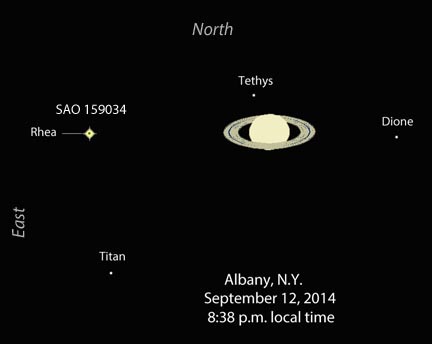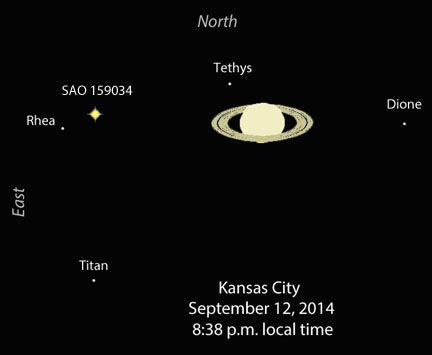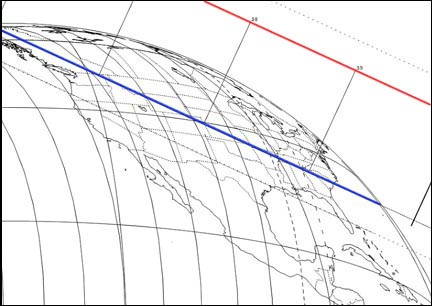Watch as Saturn's Rhea steals a star from the sky for nearly a minute on the evening of Friday September 12th.
Rarely does a planetary moon occult a bright star, but Saturn's Rhea is likely to do just that on Friday evening September 12th for skywatchers across much of the eastern U.S. and Ontario.
Thumbing back through my memory, I can't recall ever seeing this rarity. Hmmm ... I must have some reason to fly to New York that evening.
For those in the lucky locations, a clear sky and modest telescope are all you'll need.
One challenge will be to scout out an observing site with an open view to the southwest, where Saturn will be low. Stray clouds or dense haze might also be deterrents, but I trust you'll persevere.

Source: Chris Marriott's SkyMap
If you're lucky, you'll see 10.2-magnitude Rhea black out 7.6-magnitude SAO 159034 for up to 58 seconds — depending on how far you are from the center of the shadow path — between 8:38 and 8:39 p.m. Eastern Daylight Time. While Saturn's low altitude likely means soft images from air turbulence, the vanishing of the star should be obvious in a 60-mm telescope.

Source: Chris Mariott's SkyMap
The occultation map below is only the most-likely case; "The prediction is quite uncertain," says David Dunham of the International Occultation Timing Association;
"It's possible that the actual southern limit will pass almost entirely north of the Earth, so that even observers in the Northeast would have a miss, but it's also possible that it will shift south; even observers in Florida have a chance for an occultation. The dotted line parallel to the southern limit and south of it, passing approximately from Houston to Orlando, is the southern limit in case of a 1-sigma southward shift of the path, considering the various prediction errors; there is a 16% chance that the path would shift at least that far south (and an equal chance that it will shift at least a similar distance north). The chance that the occultation will occur somewhere entirely between the two dotted lines is 68%."
Still, all of us will get to see the Saturnian system temporarily invaded by a bright star posing as a moon, whether there's a hit or a miss. As Rhea and Saturn go their separate ways, SAO 159034 will appear to slowly drift away from the planet, soon giving itself away as an intruder.

We know Rhea's diameter with precision thanks to 10 years of observations by the orbiting Cassini probe, but new information about the occulted star may come to light. Although SAO 159034 is listed as a single star, occultations can sometimes reveal that seemingly solitary stars have extremely close companions that reveal themselves as stepwise drops of the star's light.
However you enjoy the event, consider that Rhea, at 949 miles (1,528 km) across, will perform that favorite occultation sleight of hand where the little guy gets to eclipse the big guy, in this case a star estimated at some 121 million miles (195 million km) across.
Learn to navigate the sky with Sky & Telescope's Pocket Sky Atlas.
 5
5









Comments
Robert-Casey
September 3, 2014 at 2:08 pm
Maybe we'd see evidence of the suspected ring system around Rhea during this event? Like the way rings were discovered around Uranus about 30 years ago. Looking for small dips of the brightness of the star in the minutes or seconds before the main event, and afterwards as well.
You must be logged in to post a comment.
Jim-Baughman
September 7, 2014 at 3:05 pm
Since Cassini has failed to find any image evidence of a ring around Rhea, observations from a billion miles away on Earth stand little chance of doing any better. If there is ring material circling Rhea it is so tenuous and fine that even 100 minute overexposures of Rhea by Cassini failed to show anything.
You must be logged in to post a comment.
Jim-Baughman
September 7, 2014 at 3:07 pm
Oops, the exposure was 100 seconds, not minutes.
You must be logged in to post a comment.
robert-simpson
September 7, 2014 at 8:54 am
It has been quite a long time since we've seen moon/star occultation. The last one I remember was July 3, 1989 when Saturn and Titan covered 28 Sag. I was just getting started in amateur astronomy, and it was quite a thrill seeing almost the entire event with our club's 12.5" reflector.
You must be logged in to post a comment.
Scorpius
September 13, 2014 at 11:16 am
After more than 10 years, I set up my telescope! I didn't see the star vanish because I wasn't at the eyepiece, but I did see it reappear. It was amazing. When is this going to happen again?
You must be logged in to post a comment.
You must be logged in to post a comment.